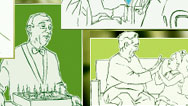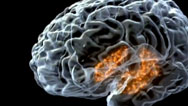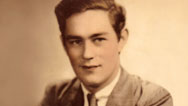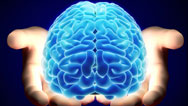Of Mice and Memory
- Posted 06.25.08
- NOVA scienceNOW
(This program is no longer available for online streaming.) Researchers have found that mice with induced memory loss are able to retrieve memories after they spend time in enriched environments that stimulate mental activity. What's more, these scientists have identified a drug that has a similar effect. It appears to promote gene activity in the brain that is important in memory. These insights may lead to a better understanding of dementia and memory-impairment disorders such as Alzheimer's.
While scientists are yet in the early stages of translating this research in mice into treatments for humans, it's striking that many Alzheimer's sufferers temporarily improve in an activity-rich environment, providing a tantalizing clue to further research and possible therapies.
Transcript
OF MICE AND MEMORY
PBS Airdate: June 25, 2008
NEIL deGRASSE TYSON: For most of us, a stroll down Memory Lane is an easy trip.
There's a good one.
But for the tens of millions suffering from memory loss, like those with Alzheimer's disease, it's different.
In some cases, memory might still be there, but the pathways in our brain that give us access to those memories might be broken or blocked, leaving the memories out of reach.
But what if your brain could build new pathways to lost memories?
As correspondent Peter Standring reports, some new research shows that someday that might just be possible.
MARGIE PETERS: People always said that she was the life of the party. She was very energetic. She was well known in her circle as a dancer, and she was just a bubbly, exuberant young woman.
Do you remember who these folks are?
PETER STANDRING: Tillie Venear is 84.
TILLIE VENEAR: Zachary? No.
MARGIE PETERS: These are your great-grandchildren.
TILLIE VENEAR: Really?
PETER STANDRING: Until a few years ago, Tillie was living a comfortable life, retired in Florida. But then she started having trouble with her memory.
MARGIE PETERS: She had a car accident. Then she got a ticket for going while a school bus was stopped. Then there was another car accident, and I started thinking, "I don't know if she's safe down there."
PETER STANDRING: Doctors said Tillie probably had Alzheimer's. She moved to an assisted living facility, but her memory just got worse and worse.
MARGIE PETERS: One day, they called and said, "Your mother's standing in her room with her pants in her hands, not knowing what to do with them." And then she started staying in bed all day and staying in her room more. Finally, one day, the phone call came. They found her in the stairwell crying, sitting there saying, "Where am I? Where am I going?"
PETER STANDRING: Alzheimer's was robbing Tillie of, not only her memories, but also her personality. Her family moved her out of assisted living to a new nursing home, and suddenly, they noticed a surprising change.
MARGIE PETERS: But this very loving, bubbly, almost girlishness, has emerged since she's been here. She became involved again. She sort of sparked a little bit more. Her exuberance came back.
PETER STANDRING: Somehow, putting Tillie in a new place brought back parts of her personality that seemed like they were gone forever. How is that possible?
When patients like Tillie regain function or seem to get their memories back, even for a short period of time, it provides clues to an amazing idea: maybe memories aren't totally lost, maybe they can be restored.
At MIT, these mice may help us find memories that are buried in our brains.
So, Dr. Tsai, what room is this that we're in now?
LI-HUEI TSAI: So, this is a room where we test the behaviors of mice.
PETER STANDRING: And what have we got here? I'm sure this is not a hot-tub.
This tub of water is a way to test learning and memory.
LI-HUEI TSAI: You can see we fill up the tank about halfway with murky water, so when you place the mouse in the tank it cannot see through. And then we place a platform that's submerged underneath the surface of the water.
PETER STANDRING: Now don't worry, the mice know how to swim, so what they have to do is learn where the platform is and climb onto it.
They practice for just 90 seconds at a time, a few times a day, and pretty soon they figure it out. And once they get the hang of it, they always remember where they can find the safe haven.
But after they've learned the route, Tsai gives them a toxic protein that destroys brain cells, and when she puts them back in the water, the mice forget where the platform is and have to be rescued.
So this mouse's brain is, basically, not functioning properly.
LI-HUEI TSAI: No, no, no. If the mouse, after vigorous training, still cannot find the platform, it clearly is impaired in their learning ability and cognitive function.
PETER STANDRING: Tsai wanted to find out, could those lost memories be restored? So after they're nice and dry, the mice get a treat.
What is this, Dr. Tsai? I'm assuming that it's not necessarily a playground for the mice?
LI-HUEI TSAI: Well, this is a Disney World for the mice.
PETER STANDRING: This experiment tests something that has been studied for many years but never really understood. It's called "environmental enrichment."
LI-HUEI TSAI: If you keep rodents in a very rich environment, with lots of toys, and house them in groups with lots of companions, then somehow, they become smarter.
PETER STANDRING: After just a short vacation at Disney World, Tsai puts the mice back in the water, and—here's the surprise—amazingly, they swim straight to the platform.
So, after a few weeks in Disney World, they go back into the water maze, and they're able to find the platform?
LI-HUEI TSAI: Right, right. They can find the platform much faster.
PETER STANDRING: Somehow, the mice got their memories back. But what's actually happening inside their brain cells?
There's a possible clue in the work of neuroscientist David Sweatt. His hobby is painting abstract images of the brain cells he studies in his lab.
J. DAVID SWEATT (University of Alabama at Birmingham): The work that's going on in the laboratory, and in neuroscience in general, right now, is the most interesting thing in the world. So, that's what I need to paint.
PETER STANDRING: Sweatt lost his mother to Alzheimer's, and now he's trying to figure out new ways of understanding how brain cells create memories.
His search starts deep inside neurons, where long strands of DNA are tightly coiled around a group of proteins called "histones."
DAVID SWEATT: It's as if you were winding sewing thread on a spool. The histones are kind of like the spool, and the DNA is wrapped around the histones like a few wraps of thread around a spool.
PETER STANDRING: Analyzing brain cells from normal mice, Sweatt discovered that when DNA is wrapped tightly around the histones, genes are hidden, but when the DNA loosens up, genes involved in learning and memory are exposed and can be switched on.
And as that happens, the brain cells appear to be making more and stronger connections with each other. This was a new pathway into the creation of memories that had never been understood before.
DAVID SWEATT: When you have a new process like that, you can think of new, entirely new and different ways to go about attacking the problem of memory dysfunction.
PETER STANDRING: Back at MIT, Li Huei Tsai had also discovered something new. The mice's stay in Disney World seemed to have sparked the same process, even in their impaired brains. Their DNA was also loosening up and making memory genes more active. And somehow, even though they'd lost a significant number of neurons, this was helping their cells make new connections, essentially rewiring the remaining neurons so their brains could work better.
LI-HUEI TSAI: We found that even though these mice have fewer neurons, each neuron seems to be more effective.
PETER STANDRING: What are the processes that are happening to allow this sort of rewiring?
LI-HUEI TSAI: That's a very important question. Because if we understand that, then you can imagine that one day maybe it's possible to have a pill that we all can take, and that will have this magical effect.
PETER STANDRING: A pill that could bring back memories? Well, it may not be so farfetched. Sweatt's lab has already studied a group of experimental drugs called HDAC inhibitors—the h stands for histones—that are involved in loosening up DNA in brain cells. And when the drugs are given to normal mice, they learn and remember better.
So Tsai decided to see if they would have any effect on her mice with damaged brain cells. She took a new group of forgetful mice and gave them the experimental drugs. And, within a short time, they also remembered how to swim straight to the platform.
LI-HUEI TSAI: We found that the HDAC inhibitors drastically improved the learning ability of our mouse model.
PETER STANDRING: And when you realized that, what did you think?
LI-HUEI TSAI: I was overjoyed.
ERIC LANDER: What's so interesting about what Li-Heui Tsai has shown, is that memories can be stored, apparently lost, and then regained. By taking that mouse and either giving it an enriched environment or certain drugs, she can show that those mice can recover some of those memories.
PETER STANDRING: There is no way to know whether these new discoveries will ever apply to humans or lead to treatments for memory disorders. But for now, they're a tantalizing insight and a new direction for more research into the mysteries of memory.
ERIC KANDEL (Columbia University): This is such a profound problem. And it is of such enormous significance because it effects the most fundamental aspects of our character, our personality, of who we are, that any advance is a step forward.
ERIC LANDER: I think these experiments are just plain amazing. They tell us what the potential is, that there's so much more potential in situations where we might have given up all hope.
PETER STANDRING: There aren't any drugs to reverse the effects of Alzheimer's in humans, but Tsai's experiments may help explain something families have known for a long time: the more stimulating the environment, the better patients like Tillie usually do.
MARGIE PETERS: ...going to feed the birds, okay? One, two, three.
PETER STANDRING: Her new nursing home is centered on a philosophy of care called the "Eden Alternative," with a special program to give Alzheimer's patients as much stimulation as they can manage.
ATTENDANT: Let's have a wonderful lunch together.
WALTER COLLINS (Briarwood Healthcare & Rehabilitation Center): Everything that we try to do is resident- or person-centered, to empower those people with dementia to make decisions to the extent that they can...
ATTENDANT What are you going to have?
TILLIE VENEAR: I'll have meatloaf.
WALTER COLLINS: ...and to provide a loving home for them, which is what they deserve.
ATTENDANT After we make the cookies, Tillie, what do we do? We put the music on and we...what?
TILLIE VENEAR: We dance!
PETER STANDRING: Tillie is thriving in this enriched environment.
MARGIE PETERS: She's made this place her own, and made her life here her own. She just became happy again.
Credits
Of Mice and Memory
- Edited by
- Nathan Hendrie
- Produced and Directed by
- Elizabeth Arledge
NOVA scienceNOW
- Executive Producer
- Samuel Fine
- Executive Editor
- Neil deGrasse Tyson
- Senior Series Producer
- Vincent Liota
- Supervising Producers
- Stephen
Sweigart
Joey David - Editorial Producer
- Julia Cort
- Development Producer
- Vinita Mehta
- Senior Editor
- David Chmura
- Production Assistant
- Fran Laks
- Compositors
- Brian Edgerton
Yunsik Noh - Music
- Rob Morsberger
- Associate Producers
- Fran Laks
Molly Longstreth
Anthony Manupelli
Win Rosenfeld
Alison Snyder - Assistant Editor
- Susan Perla
- Camera
- Jim Ball
James Callanan
Austin deBesche
Brian Dowley
Vincent Liota
Steve McCarthy - Sound Recordists
- Bernie Beaudry
Lauretta Molitor
Roger Phenix
George Shafnacker
Tom Williams - Sound Mix
- David Chmura
- Animation
- Sputnik
Animation
James LaPlante
Brian Edgerton
Anthony Kraus
Yunsik Noh
"The Forgetting," Twin Cities Public Television - Production Manager For Crowd Segment
- Candace White
- Segment Production Assistants
- Mona
Damluji
Grisha Enikolopov - NOVA scienceNOW series animation
- Edgeworx
- Three dimensional brain animation
- Courtesy Dr. Arthur W. Toga, Laboratory of Neuro Imaging at UCLA
- Archival Material
- ESA
Jet Propulsion Laboratory
Library of Congress
NASA - Special Thanks
- Briarwood
Healthcare and Rehabilitation Center, Needham, MA
Douglas Clowe
Bamidele Faboyede
Prasad Jayanti
Kimo Johnson
Eric Kee
Sue Moen
Soudan Underground Mine - A Minnesota State Park
Twin Cities Public Television
Jeff Woodward - Neil deGrasse Tyson
- is director of the Hayden Planetarium in the Rose Center for Earth and Space at the American Museum of Natural History.
- NOVA Series Graphics
- yU + co.
- NOVA Theme Music
-
Walter Werzowa
John Luker
Musikvergnuegen, Inc. - Additional NOVA Theme Music
- Ray
Loring
Rob Morsberger - Post Production Online Editor
- Spencer Gentry
- Closed Captioning
- The Caption Center
- NOVA Administrator
- Ashley King
- Publicity
- Carole McFall
Eileen Campion
Lindsay de la Rigaudiere
Victoria Louie
Kate Becker - Senior researcher
- Gaia Remerowski
- Production Coordinator
- Linda Callahan
- Paralegal
- Raphael Nemes
- Talent Relations
- Scott Kardel, Esq.
Janice Flood - Legal Counsel
- Susan Rosen
- Post Production Assistant
- Darcy Forlenza
- Associate Producer, Post Production
- Patrick Carey
- Post Production Supervisor
- Regina O'Toole
- Post Production Editors
- Rebecca Nieto
Alex Kreuter - Post Production Manager
- Nathan Gunner
- Compliance Manager
- Linzy Emery
- Supervising Producer
- Stephen Sweigart
- Business Manager
- Joseph P. Tracy
- Producers, Special Projects
- Lisa Mirowitz
David Condon - Coordinating Producer
- Laurie Cahalane
- Senior Science Editor
- Evan Hadingham
- Senior Series Producer
- Melanie Wallace
- Managing Director
- Alan Ritsko
- Senior Executive Producer
- Paula S. Apsell
This material is based upon work supported by the National Science Foundation under Grant No. 0638931. Any opinions, findings, and conclusions or recommendations expressed in this material are those of the author(s) and do not necessarily reflect the views of the National Science Foundation.
NOVA scienceNOW is a trademark of the WGBH Educational Foundation
NOVA scienceNOW is produced for WGBH/Boston by NOVA
© 2008 WGBH Educational Foundation
All rights reserved
- Image credit: (mice and test tubes) © dra_schwartz/iStockphoto
Participants
- Walter Collins
- Briarwood Healthcare & Rehab Center
- Eric Kandel
- Columbia University
- Eric Lander
- The Broad Institute www.broad.mit.edu/about/bios/bio-lander.html
- Margie Peters
- Tillie's daughter
- Peter Standring
- Correspondent
- J. David Sweatt
- University of Alabama at Birmingham neurobiology-uab.infomedia.com/bios.asp?action=form&recordID=146774
- Li-Huei Tsai
- Massachusetts Institute of Technology web.mit.edu/picower/faculty/tsai.html
Related Links
-

Of Mice and Memory: Expert Q&A
MIT's Li-Huei Tsai, who studies the neurobiology of memory, answers questions about Alzheimer's disease and more.
-

A Human Habitat
The "Eden Alternative" movement suggests that eight things are critical for the elderly to maintain mental health.
-

How Memory Works
Neurobiologists are honing in on how memories form, and then finding ways to erase them.
-

The Man Who Couldn't Remember
MIT neuroscientist Suzanne Corkin describes her decades-long relationship with a famous "pure amnesic" named H.M.
-

The Future of Brain Transplants
Will we ever grow replacement brains or do whole-brain transplants?



